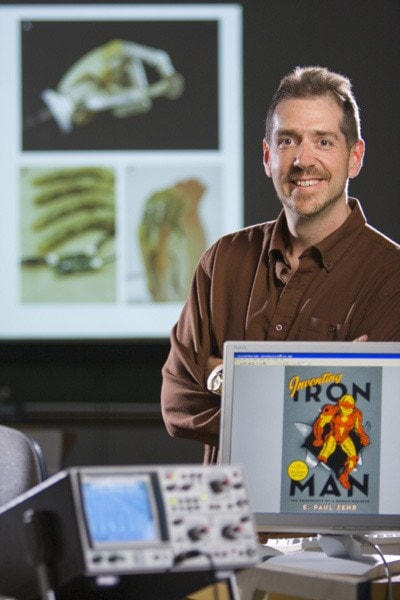A lot of us dream of becoming superheroes. While ideas of X-ray vision, super-human strength, sprouting webs or wings might be a little out of reach, one University of Victoria professor says, scientifically, there’s at least a little superhero in all of us.
“It can be frustrating to see how many people don’t realize how the body actually works, but as soon as you make reference to a cultural icon we can identify with, like Batman, we start to really think about how he got there,” says Dr. E. Paul Zehr, a professor of neuroscience and director of the Centre for Biomedical Research at UVic.
In fact, Zehr has spent a lot of his doctoral career thinking about how Batman became the superhero we all know and love. He penned his first book, Becoming Batman: The Possibility of a Superhero, in 2008. This September, he released his second, Inventing Iron Man: The Possibility of a Human Machine. Because Batman and other characters like Iron Man started as plain humans, Zehr took a special interest in sleuthing out the myths and realities behind the masked avengers.
“Considering what happens to the body along the way raises the bar for our own potential, and for pushing ourselves that extra bit, whether physically or mentally,” says Zehr, who will be giving a public lecture on his theories Thursday, Oct. 20. “It all comes down to how the human body works — it adapts to what we ask of it.”
Zehr uses the example of someone learning to play guitar. First, calluses start to form. The more you practice, the harder they become so your fingers don’t experience the pain. Zehr emphasizes this is why any exercise or training has to be started gradually, so the body has time to catch up.
“The body responds to whatever stress it’s under. We often think of stress with bad connotations these days, but we can also think of it as a pressure for the body to step up to,” he says.
When it comes to superhero myths, however, Zehr says the biggest one is the idea that someone can be the best at everything they do.
“In order to achieve that superhero status, one of the first principals is that you have to be good at a lot of things, and that’s totally attainable,” he says. “But the idea that you’ll be the best runner, the best swimmer, the best jumper — you only have to look as far as Olympic athletes to see that the ‘best’ in any sport is shaped and adapted to perfectly suit that fitness.”
So while Batman might not win an Olympic medal in anything, he can still fully outrun — or at least outsmart — a crook. Which brings us to the second principle of superherodom: mind control. Specifically, your own.
“In order to push your body the way you need to, you have to have a goal beyond what’s in front of you,” says Zehr. “If we jump on that treadmill to ‘lose weight’ then we’re going to get bored and get off. But if we want to lose weight, we have to have some deeper meaning that keeps us on. Maybe we search out a sport we love and focus on that passion, maybe we think about an outfit we want to wear more than anything else.”
In an age where we don’t have to chase our food or run from predators, or even battle crime hands-on, Zehr says we have very little crucial motivation to stay healthy. In fact, we want to keep things easy. Zehr himself has been practicing martial arts for 30 years and has three black belts. But it’s only his love of the sport — and the personal meaning he attaches to it — that keeps him coming back.
Another principal of the superhero comes mentally, but this time in the form of restraint. One of the chapters in Zehr’s first book is, “Can you KO without killing?” In order to practice a chosen activity, we actually have to keep our emotions out of it in order to get good.
“It can be really hard to take on an emotionally-challenging sport and convince our body we have no emotional connection, but that’s actually what we have to do,” says Zehr.
“It’s like in golf when you see someone make a bad shot. The good player will move on and keep golfing. The poor player will worry and obsess, and you’ll see that person’s shots get progressively worse until they can’t even putt close range.”
Because different parts of the brain are triggered when we experience emotions, the mind can actually become too “cluttered” to perform the simplest tasks, says Zehr — this is something superheroes have no trouble with, of course, at least until their damsels are in distress.
Zehr, who originally hails from Ontario, has a wife and two children. He has been a comic book fan since he was a kid, and says he always had an interest in superheroes. He was thrilled when the movie resurgence of old characters struck a few years ago.
In fact, that’s what got him thinking: in order to make body function interesting to a mass audience, he’d have to start with the books he’d want to read.
With the success of his first scientific read, he decided the world was ready for another — this time using modern-day technology to deconstruct how Iron Man creates his suit of armor.
“It’s ‘the joy of effort’ that we’re all missing these days,” Zehr says. “We forget that there’s real pleasure in just doing something — anything — and even in surprising ourselves. You never know what you’re capable of until you try.” M
EVENTS:
“Finding the Superhero in You,” Thursday, Oct. 20, 5:30 to 8:30pm, Maple Room at Strathcona Hotel, (919 Douglas). $10. Register by Oct. 14: alumni.uvic.ca/events
"Deconstructing Iron Man," Tuesday, Oct. 25, 3:30 to 5:30pm University of Victoria, McPherson Library (room A003).
